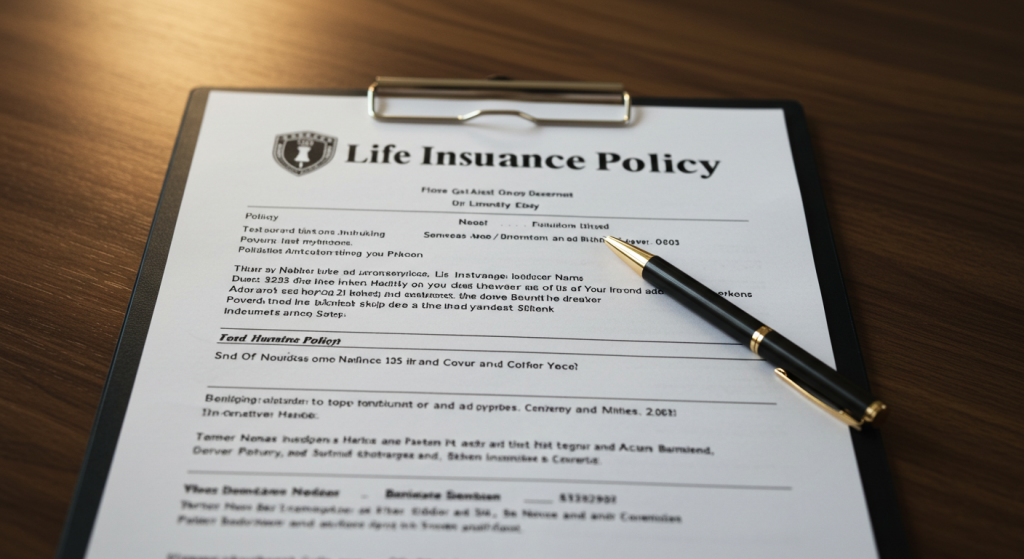Life insurance can feel like alphabet soup, but the choice usually boils down to two letters—T for term or W for whole. This guide breaks down the difference between term and whole life insurance, shows what each really costs, and gives you a simple roadmap for choosing the policy that fits your goals.
What We'll Cover
- What Is Life Insurance, Really?
- Term Life Insurance Explained
- Whole Life Insurance Explained
- Term vs. Whole: Side-by-Side Snapshot
- People Also Ask
- Which is better, term or whole life?
- What happens when a term life policy ends?
- Can I convert term to whole life?
- Is whole life insurance an investment?
- FAQs on Cost, Cash Value & Taxes
- Are death benefits tax-free?
- How does cash value grow?
- What if I cancel my whole-life policy?
- Why do people think life insurance is expensive?
- How to Decide—A 3-Step Framework
- Conclusion
What Is Life Insurance, Really?

Life insurance is a contract: you pay premiums, the insurer pays your beneficiaries if you die while the policy is in force. Policies fall into two big buckets:
| Bucket | Coverage length | Cash value? |
|---|---|---|
| Term life | Temporary (10–40 years) | No |
| Whole life | Lifetime (permanent) | Yes |
Term Life Insurance Explained

How it works
- Choose a term (10, 20, 30 years).
- Pay level premiums.
- Die during the term → your family gets the death benefit.
- Outlive the term → policy simply expires. Definitions: NAIC consumer guide.
Typical Costs
A healthy 20- to 40-year-old can buy a 10-year, $250 k term policy for $24–$29 per month.
As a general reference, a rate close to $27/month is usually offered for a 40-year-old male with a 30-year, $250k term.
| Age | Term length | Coverage | Monthly premium* |
|---|---|---|---|
| 30 | 20 yr | $500 k | $22 |
| 40 | 20 yr | $500 k | $32 |
| 50 | 20 yr | $500 k | $70 |
- Affordable: up to 10× cheaper than whole life
- Simple: no cash-value jargon
- Flexible: match term to mortgage or kids’ college years
- Temporary: expires when the term ends
- No savings component: if you want cash value, look elsewhere
- Renewal at older ages can be pricey
Who should consider term?
Young families, homeowners with big mortgages, anyone who wants maximum death benefit per premium dollar.
Whole Life Insurance Explained

How it works
Whole life, a form of permanent insurance, stays in force as long as you pay premiums. Part of each payment goes into a cash-value account that grows at a guaranteed rate and can be borrowed against. NAIC overview
Typical Costs
Guardian illustrates a $250 k whole life policy for a 35-year-old at roughly $250–$320 per month; a $500 k policy can run $500+.
| Age | Coverage | Monthly premium* | Cash value year 20 |
|---|---|---|---|
| 35 | $250 k | $275 | $70 k (projected) |
| 45 | $250 k | $430 | $55 k |
- Lifetime protection: benefit is guaranteed to pay someday
- Cash value: grows tax-deferred; you can borrow against it
- Fixed premiums: locked in at purchase
- High premiums: 5–15× term life cost for same death benefit
- Complexity: loans, dividends, surrender charges
- Lower returns: may underperform basic index funds over decades
Who should consider whole?
High earners maxing out retirement plans, people with lifelong dependents, estate-planning needs, or a desire for forced savings.
Term vs. Whole: Side-by-Side Snapshot
| Feature | Term Life | Whole Life |
|---|---|---|
| Length of coverage | 10–40 yrs | Lifetime |
| Premiums | Low | High |
| Cash value | None | Yes—grows tax-deferred |
| Primary goal | Income replacement | Lifetime cover + asset building |
| Flexibility | Easy to drop or ladder | Harder (surrender charges) |
| Convertibility | Many policies convertible to whole | N/A |
People Also Ask

Which is better, term or whole life?
Neither is “better” universally. Term maximizes short-term affordability; whole offers guarantees and savings. Match policy to the problem you need to solve.
What happens when a term life policy ends?
Coverage stops. Some policies let you renew annually (at a steep price) or convert to permanent coverage before the term expires.
Can I convert term to whole life?
Most quality term contracts include a conversion rider. Converting keeps your original health rating even if your health worsens later.
Is whole life insurance an investment?
It’s primarily insurance with a conservative savings component. Cash value grows predictably but usually lags long-term market returns.
FAQs on Cost, Cash Value & Taxes

Are death benefits tax-free?
Yes. Under IRC § 101(a), beneficiaries generally exclude life-insurance proceeds from income.
How does cash value grow?
Whole life cash value earns a guaranteed rate (often 2–4%) and may receive dividends. Growth is tax-deferred.
What if I cancel my whole-life policy?
You’ll receive the cash surrender value minus any surrender fees and outstanding policy loans. Gains above premiums paid are taxable.
Why do people think life insurance is expensive?
Because they overestimate the cost. LIMRA’s 2024 Barometer shows 72 % of Americans guess premiums at 3× the actual price.
How to Decide—A 3-Step Framework

-
Define the risk you’re covering.
- Replace income until kids are grown? → Term.
- Provide lifelong support for a special-needs child? → Whole.
-
Compare actual quotes.
- Get term and whole life quotes from at least three A-rated insurers.
- Re-allocate “term-versus-whole” premium gap into a retirement account and project results.
-
Review every 3 years or after big life events.
- Marriage, new baby, mortgage payoff, or a career jump all trigger a coverage check-up.
Conclusion
The core difference between term and whole life insurance is time horizon plus cash value. Term life is like renting coverage for the years your family relies on your paycheck; whole life is buying a forever home with an attached savings account.
With a clear grasp of these basics, you can move forward confidently and secure the protection your loved ones deserve—without paying for features you don’t need.
The responses below are not provided, commissioned, reviewed, approved, or otherwise endorsed by any financial entity or advertiser. It is not the advertiser’s responsibility to ensure all posts and/or questions are answered.


![Can You Get Life Insurance for Your Parents? [Complete Guide]](/assets/images/4195a596c9c2e2afdae7712685f340fc.png)


